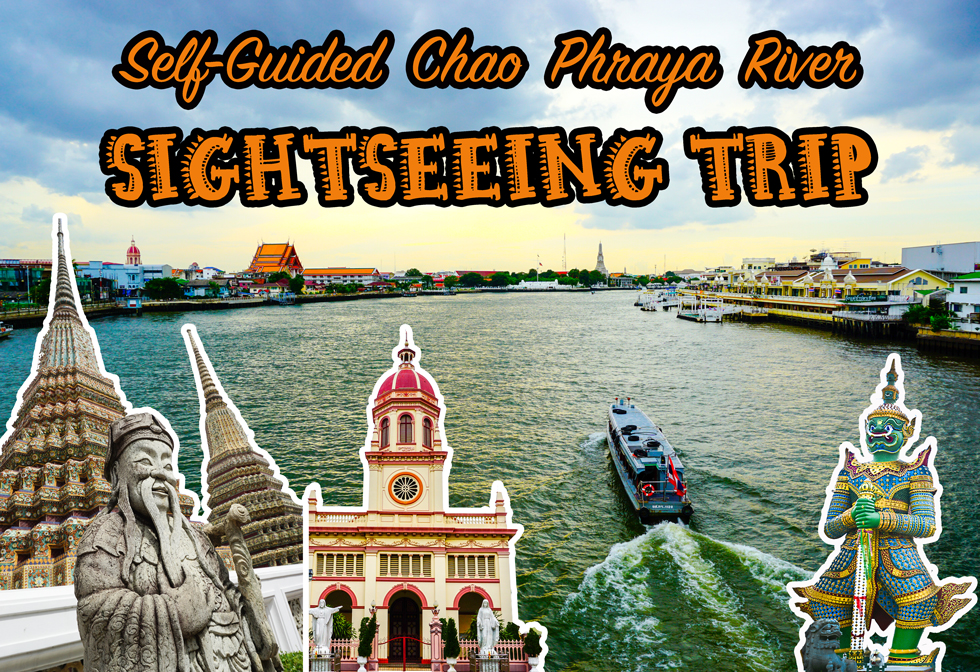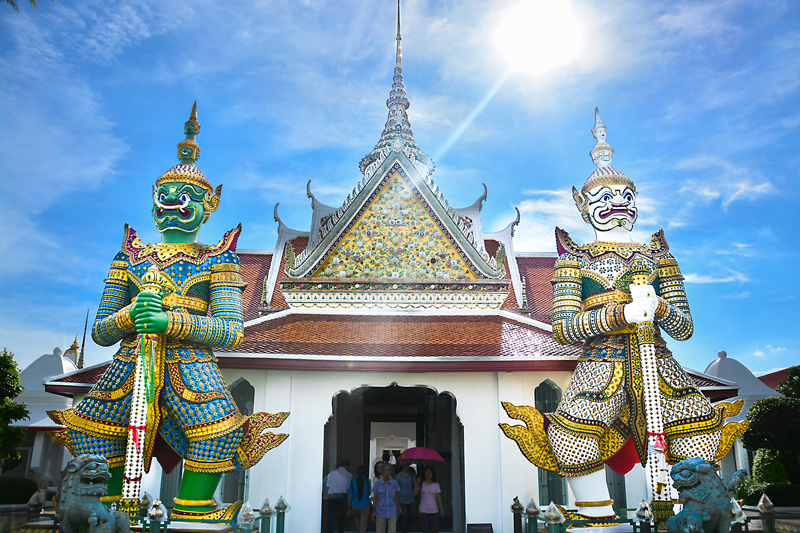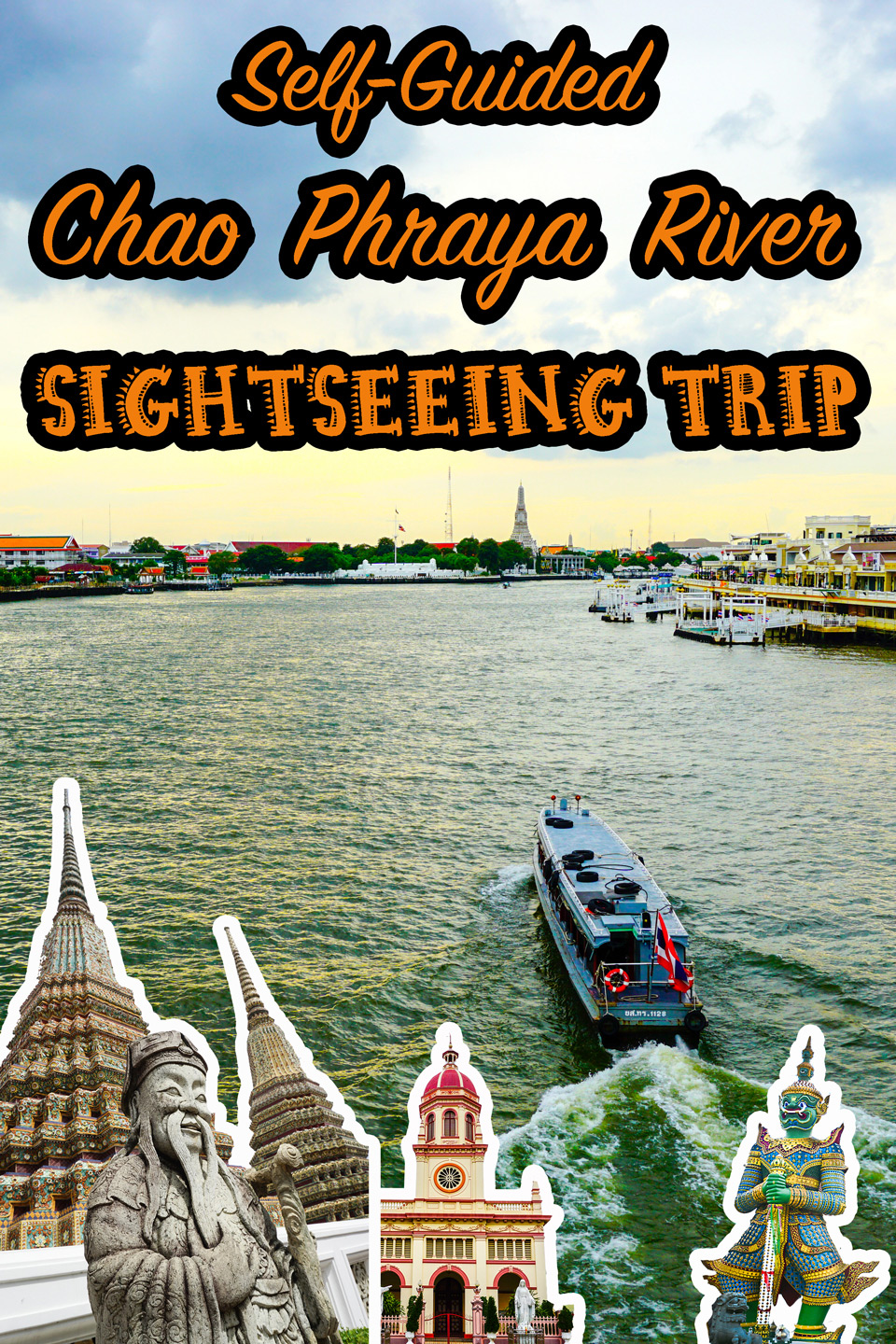
Self-Guided Chao Phraya River Sightseeing Trip
The 12-kilometer banks of Bangkok’s Chao Phraya River is home to a handful of noteworthy attractions and places of interest for travelers. Taking a Chao Phraya river ferry and visiting these attractions is one of the most popular things to do in Bangkok. In this blog, we suggest a full-day do-it-yourself Chao Phraya river sightseeing itinerary which covers both famous tourist attractions and hidden cultural neighborhoods in Bangkok’s Old City. If you’re ready, read on!
Which River Ferries to Take on a Self-Guided Chao Phraya River Sightseeing Trip?
 Orange Flag, Chao Phraya Express Boat
Orange Flag, Chao Phraya Express Boat Inside an Orange Flag boat, Chao Phraya Express Boat
Inside an Orange Flag boat, Chao Phraya Express Boat
You want to start at Sathorn Pier (Saphan Taksin BTS Station, Exit 2), the major pier on the Chao Phraya River. The bustling pier is heavily trafficked by passenger boats. It serves hotel ferries, the Asiatique ferry, and Chao Phraya Express Boats, all of which have their own piers. You want to use Chao Phraya Express Boat service. The company offers 5 types of boats: Orange Flag, Yellow Flag, Green Flag, Blue Flag (Tourist Boat), and No Flag (Local Line). Each type has its own routes and makes different stops. Look for the tiny triangle flags at the roofs of the boats.
 The sign of Chao Phraya Express Boat pier is marked clearly. Just follow the sign
The sign of Chao Phraya Express Boat pier is marked clearly. Just follow the sign
On the pier, you will see the kiosk selling One-Day River Pass (฿180), which is the ticket for the Tourist Boat stopping at major tourist attractions. Tour guides are available onboard. The One-Day River Pass is good if you want to stay on a tourist path. But we suggest you get off the beaten tourist path by following our itinerary and not taking the Blue Flag boats.
 Chao Phraya Express Boat route map
Chao Phraya Express Boat route map
Fares of Orange Flag and Yellow Flag boats are ฿15 and ฿20, respectively, per trip. Fares of the No Flag and Green Flag boats depend on distance travelled (between ฿9 and ฿35). The fares are paid at the booth before boarding or to the staff once you’re onboard. Of all the 4 types, the Orange Flag boats are your best bet. They stop at all the most popular piers, and run every 10 to 20 minutes from 6am to 7pm.
One Day Self-Guided Chao Phraya River Sightseeing Itinerary
*Always take an Orange-Flag Boat

Briefly about Each Attractions on the Chao Phraya River Sightseeing Itinerary
1. Wat Arun Temple

The temple is the most visually striking landmark towering over the Chao Phraya River. The central prang or stupa, standing 80 meters tall, is intricately decorated with colorful pieces of porcelain. The porcelain was used as ballasts in boats traveling to Bangkok from China. You can climb up to the middle level of the central prang and be rewarded with a beautiful view of the river. You can even see the Grand Palace and Wat Pho, your next stop, from here.

Another photo spot is the big giant sculptures that guard the main entrance to the ubosot. These giants are characters from Ramayana, an ancient Indian epic that has a heavy influences on Thai art. If you want to visit this temple, Wat Pho, and other iconic attractions in Bangkok’s Old City on a Tuk Tuk, have a look at The Bangkok Highlights Tour.

2. Wat Pho Temple

Wat Pho is one of the largest temple complexes in Bangkok. It’s a 10-minute walk from the Grand Palace. The must see here is the reclining Buddha that measures 46 meters long. The statue is covered in gold leaf. Behind the ubosot, stand 4 looming pagodas dedicated to the first 4 kings of Bangkok. The pagodas are decorated with colorful tiles. Wat Pho is a great place to take traditional Thai massage. It could be a bit pricey. But the service is provided by really skillful masseuses.
 Rue-si Datton statues at Wat Pho
Rue-si Datton statues at Wat Pho
In the courtyards of Wat Pho, there are comical looking Chinese statues. They were used as ballasts in boats from China. Rue-si Datton statues elaborate yoga postures used along with Thai massage trainings.

3. Museum Siam

The museum is set in a beautiful yellow historic building served for Ministry of Commerce. Via fun interactive exhibitions, you can learn about Thai identity, history of the people of Thailand, and Thailand’s relationships with neighboring cultures. Check their website and Facebook page for upcoming events to plan your visit to the museum.
4. Wang Lang Market

Wang Lang is a traditional and authentic market appealing to locals. There are hardly any tourists here. You’ll find stalls selling local clothing, cheap beauty and fashion products, but will be overwhelmed by street food carts and local restaurants. From meat skewers, to rice with assortments, noodles, Pad Thai, Thai-style Sushi, a variety of traditional Thai desserts and more. It’s best to visit before 2pm when the market starts to die down. For a complete guideline of what to eat at Wang Lang Market, click here. Wang Lang Market is featured in our Thonburi Food & Canals Adventure Tour.
5. Kudee Jeen Village
 The Catholic Santa Cruz Church
The Catholic Santa Cruz Church
This historic village is known as a community where Thai people of 3 beliefs live together in harmony: Catholic, Muslim, and Taoism. Upon arrival from the river promenade, you’ll be greeted by the beautiful Santa Cruz church built around 1770. To your right (facing the church), is a maze-like alleys of the village residential area. You may allow yourself to get lost here or find Kudee Jeen Soi 3 (Alley 3) to visit Baan Kudichin Museum. The house-turned-museum displays an exhibition of Portuguese settlers in Siam, an ancient Thai kingdom, and old artifacts of the house owner. The Catholic residents of this village are descendants of these Portuguese people.
 An old wooden house spotted from the promenade
An old wooden house spotted from the promenade
Back on the promenade, there is a Taoist shrine, Kian Un Keng, dedicated to the Goddess Guanyin. The shrine’s courtyard is very peaceful. The Muslim quarter is called Kudee Khao and is located across Arun Amarin road, away from the river. If you want a guided tour through Kudee Jeen Village, check out this tour.
 Kian Un Keng Shrine
Kian Un Keng Shrine
6. The Memorial Bridge & Pak Klong Talad Flower Market
 A sunset view from the Memorial Bridge
A sunset view from the Memorial Bridge
The green metal Memorial Bridge is a good spot to catch sunsets over the winding Chao Phraya river though it’s not that high. Next to it is Bangkok’s biggest flower market that opens 24 hours but is busy and more colorful at night. You’ll enjoy the bustling scene of trolleys transporting piles of flowers and vendors calling out for customers go about their business. The flowers here are sold to retailers around the city, and to flower vendors located nearby Buddhist temples. The flower market is featured in our popular tour Best Eats Midnight Food Tour by Tuk Tuk.
7. Chinatown

The famous street food market of Bangkok, Chinatown becomes alive in the evening when sidewalks are occupied by food vendors and pop-up restaurants. If you’re not after the best restaurants in Chinatown, you’ll find food from any vendors satisfying. Everything is literarily tasty in Chinatown. For seafood, try the famous T & K or Lek & Rat, their competitor. They sit opposite to each other on Phadung Dao Rd. For Dim Sum, try The Canton House But if you’re after the restaurants known by locals to serve the best specialty, or prefer a guided experience, you’d better join a walking food tour in Chinatown.


Save this poster on your Pinterest to share this blog with your friends!





